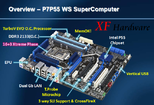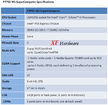- Joined
- Oct 9, 2007
- Messages
- 47,677 (7.43/day)
- Location
- Dublin, Ireland
| System Name | RBMK-1000 |
|---|---|
| Processor | AMD Ryzen 7 5700G |
| Motherboard | Gigabyte B550 AORUS Elite V2 |
| Cooling | DeepCool Gammax L240 V2 |
| Memory | 2x 16GB DDR4-3200 |
| Video Card(s) | Galax RTX 4070 Ti EX |
| Storage | Samsung 990 1TB |
| Display(s) | BenQ 1440p 60 Hz 27-inch |
| Case | Corsair Carbide 100R |
| Audio Device(s) | ASUS SupremeFX S1220A |
| Power Supply | Cooler Master MWE Gold 650W |
| Mouse | ASUS ROG Strix Impact |
| Keyboard | Gamdias Hermes E2 |
| Software | Windows 11 Pro |
ASUS, known for its single-socket workstation motherboards, is preparing the first enterprise-grade socket LGA-1156 motherboard. The ASUS P7P55 WS SuperComputer builds on the features of its socket LGA-1366 cousins, by offering as many as five PCI-Express 2.0 x16 slots, a massive 16+3 phase CPU VRM, support for DDR3-2133 by overclocking, and the latest multi-GPU standards support.
Based on the Intel P55 chipset, the P7P55 WS SuperComputer makes use of a PCI-E bridge chip that allows it to hold at least four PCI-E 2.0 x16 devices (electrical 4x PCI-E x8), with a PCI-E x16 electrically x4. Both 3-way SLI and 4-way CrossFireX are supported. Connectivity is care of two gigabit Ethernet controllers, 8 USB 2.0 ports on the rear-panel, and another six internal, Firewire, and 8-channel audio with digital IO ports and DTS support.
ASUS includes its own design enhancements, including XtremePhase VRM, TurboV EVO voltage management, and a probe microchip. It doesn't look like ASUS will add this to its first wave of motherboard launches that coincide with those of Intel's first LGA-1156 processors, but expect this to be out at least in October.


View at TechPowerUp Main Site
Based on the Intel P55 chipset, the P7P55 WS SuperComputer makes use of a PCI-E bridge chip that allows it to hold at least four PCI-E 2.0 x16 devices (electrical 4x PCI-E x8), with a PCI-E x16 electrically x4. Both 3-way SLI and 4-way CrossFireX are supported. Connectivity is care of two gigabit Ethernet controllers, 8 USB 2.0 ports on the rear-panel, and another six internal, Firewire, and 8-channel audio with digital IO ports and DTS support.
ASUS includes its own design enhancements, including XtremePhase VRM, TurboV EVO voltage management, and a probe microchip. It doesn't look like ASUS will add this to its first wave of motherboard launches that coincide with those of Intel's first LGA-1156 processors, but expect this to be out at least in October.


View at TechPowerUp Main Site



